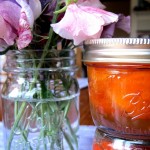The Evolution of My Canvolution
 I have not begun canning yet this year - it feels early yet to me. In my experience, you typically purchase a bushel of tomatoes on the second hottest day of the year and then can them up on the hottest day of the year. The same goes for peaches - anything that needs a really long time processing in the water bath.
I have not begun canning yet this year - it feels early yet to me. In my experience, you typically purchase a bushel of tomatoes on the second hottest day of the year and then can them up on the hottest day of the year. The same goes for peaches - anything that needs a really long time processing in the water bath.
Don’t get me wrong, I’m not a novice when it comes to canning and preserving. I grew up watching my mom making Persian pickles (torshis - from the Persian torsh, which means "sour") and elegant concoctions such as candied watermelon rind and jams made from a pink fragrant dried rose petal sent from Iran. The color of the resulting jam was beautiful. However, my childish palate shied away from such a floral and sweet flavor, the same one that would keep me away from my mom’s baklava for years. Now that I am older and wiser, I take that baklava whenever it is offered to me. While my mom’s concoctions resemble the old school heavy syrup method of preserving, where fruit pieces are left whole and are served more like a confection with tea, I take a lighter approach. For years, I used basic recipes that you see in all extension booklets, with lots of sugar and water baths. Nothing too crazy in the jam and preserve the world. If I was daring, I would add a tad bit of lemon rind to each jar. I was afraid of killing someone with my attempts at canning. Twenty-two years later, no one has complained or toppled over.
A few years ago, I picked up some Christine Ferber jams in Paris. I loved her clean fruit flavors and additions of spices to some of her jam concoctions. When her book, Mes Confitures, was translated into English, I picked it up and have used it religiously as my guide to preserving the most soft fruits. Her method can be a bit time consuming - there is a lot of maceration and settling before things get canned. It’s not a method I would suggest if you were planning to leave on vacation the following day. However, the steps are easy and I think to make for a well-textured and beautiful preserve that will bring you back to summer sometime in January. While Ferber doesn’t give recommendations for water bath canning, I add this step to the process to satisfy my scientist/fastidious side. I have not seen a degradation in the final product. Most fruit preserve recipes call for a 5 or 10-minute bath, so that is what I use. I also prefer weighing the ingredients using a simple kitchen scale instead of using measuring cups.
Editor's note: Christine Ferber has been called "The Fairy Godmother of Preserving" and her book, Mes Confitures is amazing. But, she uses the "inversion" method of sealing her jars, which isn’t approved by the USDA or by us. We recommend water-bath or pressure canning of all canned goods.
CAA Contributor Nazila Merati has lived in the Seattle area all of her life. She enjoys canning and preserving food all year around. While she favors the soft fruits, she is not averse to making pickles when overloaded by cucumbers. She is inspired by the Farm Journal Freezing and Canning Cookbook, her friends Beth and Carol, Christine Ferber, and the empty jars that come back from thankful neighbors. She is currently endeavoring to understand Persian Pickling and preserving techniques. She blogs sporadically about travel and learning to cook Persian food at banamak.org.
Comments (0)
0